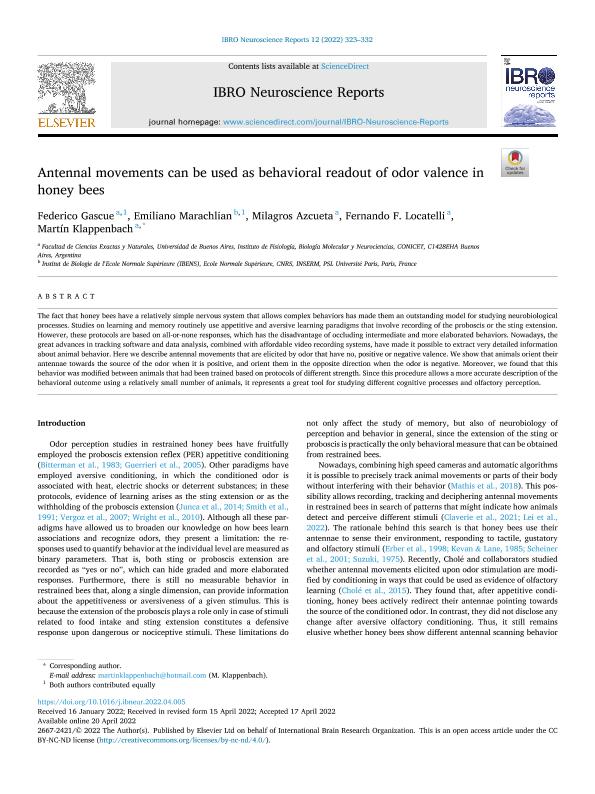Artículo
Antennal movements can be used as behavioral readout of odor valence in honey bees
Gascue, Federico Andrés ; Marachlian, Emiliano
; Marachlian, Emiliano ; Azcueta, Milagros; Locatelli, Fernando Federico
; Azcueta, Milagros; Locatelli, Fernando Federico ; Klappenbach, Martín
; Klappenbach, Martín
 ; Marachlian, Emiliano
; Marachlian, Emiliano ; Azcueta, Milagros; Locatelli, Fernando Federico
; Azcueta, Milagros; Locatelli, Fernando Federico ; Klappenbach, Martín
; Klappenbach, Martín
Fecha de publicación:
06/2022
Editorial:
Elsevier
Revista:
IBRO Neuroscience Reports
ISSN:
2667-2421
Idioma:
Inglés
Tipo de recurso:
Artículo publicado
Clasificación temática:
Resumen
The fact that honey bees have a relatively simple nervous system that allows complex behaviors has made them an outstanding model for studying neurobiological processes. Studies on learning and memory routinely use appetitive and aversive learning paradigms that involve recording of the proboscis or the sting extension. However, these protocols are based on all-or-none responses, which has the disadvantage of occluding intermediate and more elaborated behaviors. Nowadays, the great advances in tracking software and data analysis, combined with affordable video recording systems, have made it possible to extract very detailed information about animal behavior. Here we describe antennal movements that are elicited by odor that have no, positive or negative valence. We show that animals orient their antennae towards the source of the odor when it is positive, and orient them in the opposite direction when the odor is negative. Moreover, we found that this behavior was modified between animals that had been trained based on protocols of different strength. Since this procedure allows a more accurate description of the behavioral outcome using a relatively small number of animals, it represents a great tool for studying different cognitive processes and olfactory perception.
Palabras clave:
Apis
,
Behavior
,
Neuroscience
,
Sensory systems
Archivos asociados
Licencia
Identificadores
Colecciones
Articulos(IFIBYNE)
Articulos de INST.DE FISIOL., BIOL.MOLECULAR Y NEUROCIENCIAS
Articulos de INST.DE FISIOL., BIOL.MOLECULAR Y NEUROCIENCIAS
Citación
Gascue, Federico Andrés; Marachlian, Emiliano; Azcueta, Milagros; Locatelli, Fernando Federico; Klappenbach, Martín; Antennal movements can be used as behavioral readout of odor valence in honey bees; Elsevier; IBRO Neuroscience Reports; 12; 6-2022; 323-332
Compartir
Altmétricas



